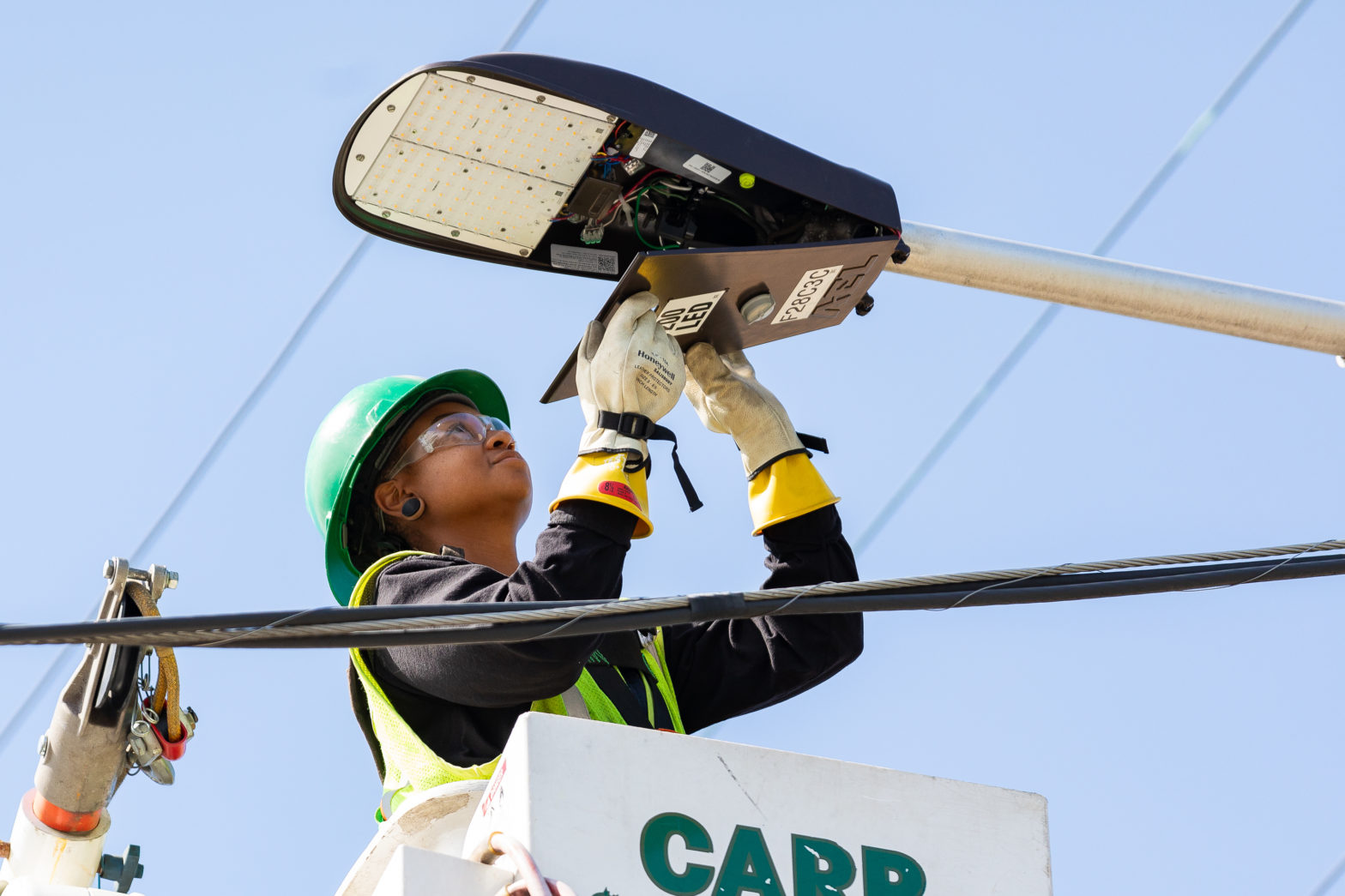
Photo: Philadelphia Energy Authority
Public safety data guides Philadelphia’s city-wide streetlight upgrade
29 August 2023
by Sarah Wray
Work is underway to replace 130,000 streetlights with LEDs in Philadelphia and connect them to a lighting management system.
The US$91 million project is expected to reduce streetlighting energy use by more than 50 percent and cut municipal carbon emissions by more than nine percent, while also boosting safety.
It is the largest energy conservation project the city has undertaken.
“As we move towards a resilient and climate-ready Philadelphia, the Philly Streetlight Improvement Project exemplifies the win-win infrastructure investments the city needs,” said Mayor Jim Kenney. “LED streetlights will enhance the quality of life for all Philadelphians by providing better, more reliable lighting. It will also help us advance toward our city’s goals for Vision Zero, by providing better visibility to reduce traffic crashes, as well as ensure our continued progress toward meeting our 2030 energy and climate goals.”
Installation, which will be carried out over two years, is being prioritised in neighbourhoods where public safety needs are highest, as identified through data relating to night-time crime, night-time vehicle crashes, gun violence, and Delaware Valley Regional Planning Commission’s Indicators of Potential Disadvantage.
Funding
Through energy savings, avoided operations and maintenance costs, and energy efficiency rebates, the project is designed to be cost-neutral over the 20-year financing period. It is funded through the city’s first-ever Sustainability Bond, which was issued by the Philadelphia Energy Authority.
Further benefits of the new lighting system include the ability to dim and brighten fixtures and receive instant updates on outages.
“Right now, there’s really only one way to know that any of our streetlights are out and that’s to visually verify – whether that’s a contractor on behalf of the city or residents who are reporting through our 311 system,” Katie Bartolotta, VP of Policy and Strategic Partnerships at Philadelphia Energy Authority, told Cities Today.
“One thing that we’re really interested to look at is the pre-installation 311 call volume with respect to streetlights being out and what that looks like after, knowing that we’ll have a lighting management system that gives us an instantaneous response when a light is out.”
Bartolotta said several academic institutions have also expressed an interest in working with the city and PEA on how the impact of the lighting on public safety might be captured, and this is something that is being explored.
She noted: “We also want to recognise, especially when it comes to public safety, that this is just one facet of very complicated inputs that go into safety in communities in the evening time.”
Fixtures are designed to have a warm colour temperature, a diffused lens for enhanced visual comfort, and higher lumen outputs in priority installation areas.
The design is based on community feedback received from surveys taken across 15 trial installations.
Challenges and surprises
“Part of the challenge of this project is just the scope and scale,” said Bartolotta. “It’s a really long development project relative to other types of projects.”
The 13-month development period included a field audit of each light fixture to gather baseline data so that progress and savings can be calculated. The contract with Ameresco, which is the lead contractor and integrator for the project, includes a performance guarantee.
Bartolotta adds that she was pleasantly surprised at council and resident buy-in for the project.
“My expectation was that folks were going to need to really understand the why of the project to be supportive of it,” she said.
“But because [light] is such a personal issue to folks and it reaches every single neighbourhood in the city, it really wasn’t a matter of whether or not we should do this project at this kind of speed and scale – the emphasis was on when we were going to start.”
Future-proofing
The request for proposals for the project specified that the network should be capable of supporting future smart city applications.
No specific plans have been announced but Bartolotta said this was about “future-proofing” the network.
“It would be a project scope that’s separate from what we’re doing now but hopefully potentially enabled by the network that we’ve put together,” she commented.
Last year, in a separate project, Philadelphia’s Office of Innovation and Technology launched a smart streetlight pilot with Comcast, Juganu and US Ignite. Fourteen sensor-equipped streetlights were installed to count pedestrians, vehicles and cyclists, and to monitor temperature, humidity and air quality.
Akshay Malik, Philadelphia’s Smart Cities Director, told Cities Today that the pilot is now in its second and final phase.
The latest phase adds six additional cameras to cover the block intersections and gather multi-modal turning count data.
“We are transitioning from posting the data in a data centre to a cloud and that is going to make access much easier,” he said.
“The project so far was really interesting from an operations learning perspective. The second phase I am hoping is going to be a more interesting phase to dig deeper into the data analysis part of things.”











